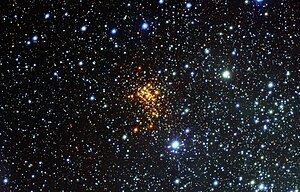| Observation data Epoch J2000 Equinox J2000 | |
|---|---|
| Constellation | Ara |
| Right ascension | 16h 47m 7.5041s [1] |
| Declination | −45° 52′ 29.123″ [1] |
| Apparent magnitude (V) | 15.807 [2] |
| Characteristics | |
| Spectral type | A3Ia+ [3] |
| Apparent magnitude (J) | 6.407 [4] |
| Apparent magnitude (H) | 5.271 [4] |
| Apparent magnitude (K) | 4.632 [4] |
| Astrometry | |
| Proper motion (μ) |
RA: −1.574
[1]
mas/
yr Dec.: −4.036 [1] mas/ yr |
| Parallax (π) | 0.0119 ± 0.0812 mas [1] |
| Distance | 13,400
ly (4,120 [5] pc) |
| Details [3] | |
| Mass | 40 M☉ |
| Radius | 376.9 R☉ |
| Luminosity | 730,000 L☉ |
| Surface gravity (log g) | ~0.65 cgs |
| Temperature | ~8,500 K |
| Rotational velocity (v sin i) | 10 km/s |
| Age | 10.4+1.3 −1.2 [5] Myr |
| Other designations | |
| Database references | |
| SIMBAD | data |
Westerlund 1-243 or Wd 1-243 is a luminous blue variable (LBV) star undergoing an eruptive phase located within the outskirts of the super star cluster Westerlund 1. [6] Located about 13,400 ly (4,100 pc) from Earth, [5] it has a luminosity of 0.73 million L☉ making it one of the most luminous stars known. [3]
Observation
Westerlund 1-243 is the second brightest star in Westerlund 1, behind only Westerlund 1-4. [2] It is one of several different hypergiant stars in Westerlund 1. It may also have a companion star, possibly an O-type supergiant. [7]
Spectrum
Westerlund 1-243 displays a complex, time-varying spectrum with emission lines of hydrogen, helium and Lyman-α pumped metals, forbidden lines of nitrogen and iron, and a large number of absorption lines from neutral and singly-ionized metals. Many lines are complex emission/absorption blends, with significant spectral evolution occurring on timescales of just a few days. [3]
Properties
Westerlund 1-243 has a temperature of ~8,500 K determined from modelling the absorption line spectrum. It has expanded to a radius of 376.9 R☉, and a Rosseland radius of 450 R☉. It is radiating at a luminosity of 730,000 L☉. It is losing mass at a rate of 6.1×10−7 M☉/yr. [3]
Evolution
Westerlund 1-243 is believed to be either in an advanced pre- red supergiant LBV phase, or has evolved through the RSG phase and returned to the blue side of the HR diagram. In the future it is expected to evolve toward a WR phase. The K-band spectrum also implies a higher temperature than that of a typical yellow hypergiant and suggests that Westerlund 1-243 may be evolving back towards a hotter state. [3]
References
- ^ a b c d e Vallenari, A.; et al. (Gaia collaboration) (2023). "Gaia Data Release 3. Summary of the content and survey properties". Astronomy and Astrophysics. 674: A1. arXiv: 2208.00211. Bibcode: 2023A&A...674A...1G. doi: 10.1051/0004-6361/202243940. S2CID 244398875. Gaia DR3 record for this source at VizieR.
- ^ a b Lim, Beomdu; Chun, Moo-Young; Sung, Hwankyung; Park, Byeong-Gon; Lee, Jae-Joon; Sohn, Sangmo T.; Hur, Hyeonoh; Bessell, Michael S. (February 2013). "The Starburst Cluster Westerlund 1: The Initial Mass Function and Mass Segregation". The Astronomical Journal. 145 (2): 46. arXiv: 1211.5832. Bibcode: 2013AJ....145...46L. doi: 10.1088/0004-6256/145/2/46. ISSN 0004-6256. S2CID 56143904.
- ^ a b c d e f Ritchie, B. W.; Clark, J. S.; Negueruela, I.; Najarro, F. (December 2009). "Spectroscopic monitoring of the luminous blue variable Westerlund 1-243 from 2002 to 2009". Astronomy and Astrophysics. 507 (3): 1597–1611. arXiv: 0910.0529. Bibcode: 2009A&A...507.1597R. doi: 10.1051/0004-6361/200912986. ISSN 0004-6361. S2CID 2004271.
- ^ a b c Cutri, Roc M.; Skrutskie, Michael F.; Van Dyk, Schuyler D.; Beichman, Charles A.; Carpenter, John M.; Chester, Thomas; Cambresy, Laurent; Evans, Tracey E.; Fowler, John W.; Gizis, John E.; Howard, Elizabeth V.; Huchra, John P.; Jarrett, Thomas H.; Kopan, Eugene L.; Kirkpatrick, J. Davy; Light, Robert M.; Marsh, Kenneth A.; McCallon, Howard L.; Schneider, Stephen E.; Stiening, Rae; Sykes, Matthew J.; Weinberg, Martin D.; Wheaton, William A.; Wheelock, Sherry L.; Zacarias, N. (2003). "VizieR Online Data Catalog: 2MASS All-Sky Catalog of Point Sources (Cutri+ 2003)". CDS/ADC Collection of Electronic Catalogues. 2246: II/246. Bibcode: 2003yCat.2246....0C.
- ^ a b c Beasor, Emma R.; Davies, Ben; Smith, Nathan; Gehrz, Robert D.; Figer, Donald F. (May 2021). "The Age of Westerlund 1 Revisited". The Astrophysical Journal. 2103 (1): arXiv:2103.02609. arXiv: 2103.02609. Bibcode: 2021ApJ...912...16B. doi: 10.3847/1538-4357/abec44. S2CID 232110879.
- ^ Clark, J. S.; Negueruela, I. (January 2004). "A newly identified Luminous Blue Variable in the galactic starburst cluster Westerlund 1". Astronomy and Astrophysics. 413 (2): L15–L18. arXiv: astro-ph/0312058. Bibcode: 2004A&A...413L..15C. doi: 10.1051/0004-6361:20031700. ISSN 0004-6361. S2CID 2033421.
- ^ Ritchie, B. W.; Clark, J. S.; Negueruela, I.; Najarro, F. (2022). "A VLT/FLAMES survey for massive binaries in Westerlund 1. VIII. Binary systems and orbital parameters". Astronomy and Astrophysics. 660: A89. arXiv: 2111.12463. Bibcode: 2022A&A...660A..89R. doi: 10.1051/0004-6361/202142405. S2CID 244866093.
